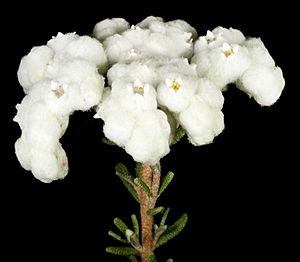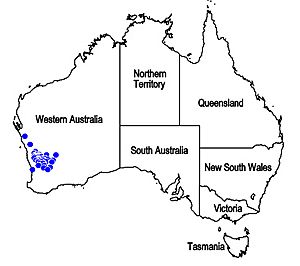Dicrastylis rugosifolia facts for kids
Quick facts for kids Dicrastylis rugosifolia |
|
|---|---|
 |
|
| Dicrastylis rugosifolia | |
| Scientific classification | |
 |
|
| Occurrence data from AVH) | |
| Synonyms | |
|
Mallophora rugosifolia Munir |
Dicrastylis rugosifolia is a type of flowering plant. It belongs to the Dicrastylis group of plants. This plant is part of the Lamiaceae family. You can only find it in the south-west part of Western Australia. This means it is special to that area.
Contents
About This Plant
Dicrastylis rugosifolia is a bushy plant. It grows low to the ground, spreading out. It can reach about 35 centimeters (14 inches) tall. Its stems are round.
Leaves and Flowers
The leaves grow opposite each other on the stem. They are 4 to 7 millimeters long. They are also 0.8 to 1.5 millimeters wide. The leaves have tiny hairs that look like branches. Their surface is bumpy, almost like it has blisters.
This plant has small leaf-like parts called bracts. They are 1.5 to 4 millimeters long. The flowers do not have stalks; they sit directly on the stem.
The flower has five parts at its base, called the calyx. These parts are 1.7 to 2 millimeters long. They are also covered in branched hairs. The main part of the flower, called the corolla, is white or cream. It is 3 to 4 millimeters long. It does not have any spots or stripes inside. Each flower has five stamens, which are the parts that make pollen.
You can usually see these flowers from August to December.
Where It Grows
This plant grows in specific areas of Western Australia. These areas include the Avon Wheatbelt, Coolgardie, and the Geraldton Sandplains. These are special natural regions.
Plant Names and History
Scientists give plants special names. This helps everyone know exactly which plant they are talking about.
How It Got Its Name
The plant Dicrastylis rugosifolia was first described in 1977. A scientist named Ahmad Abid Munir gave it the name Mallophora rugosifolia. Later, in 2005, another scientist, Barbara Lynette Rye, studied it again. She decided it belonged in a different group. So, she renamed it Dicrastylis rugosifolia.

